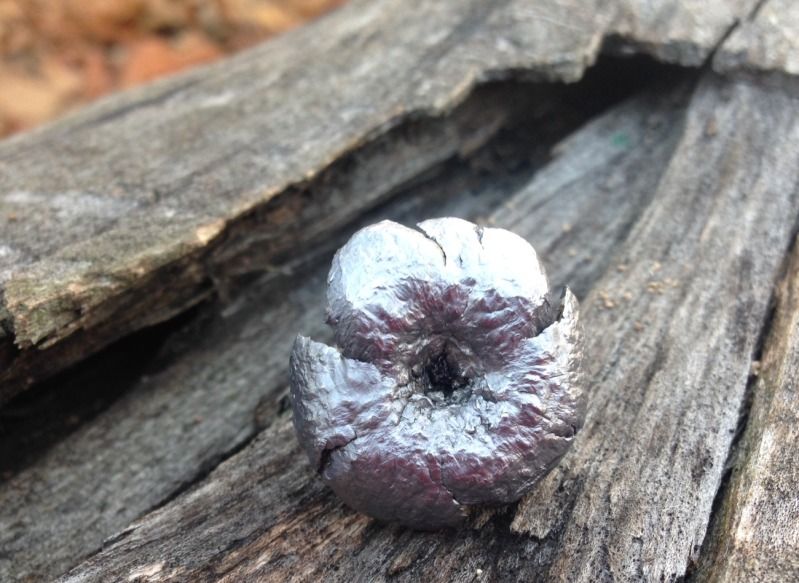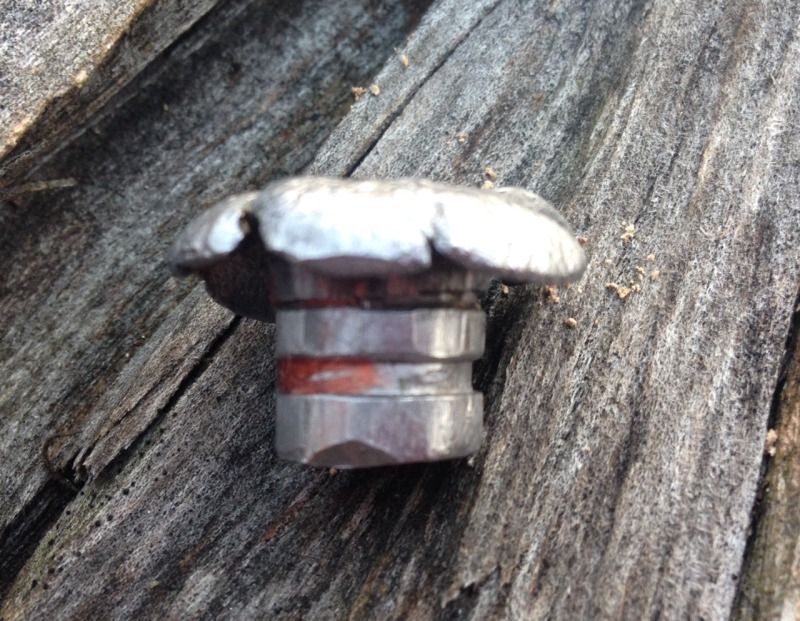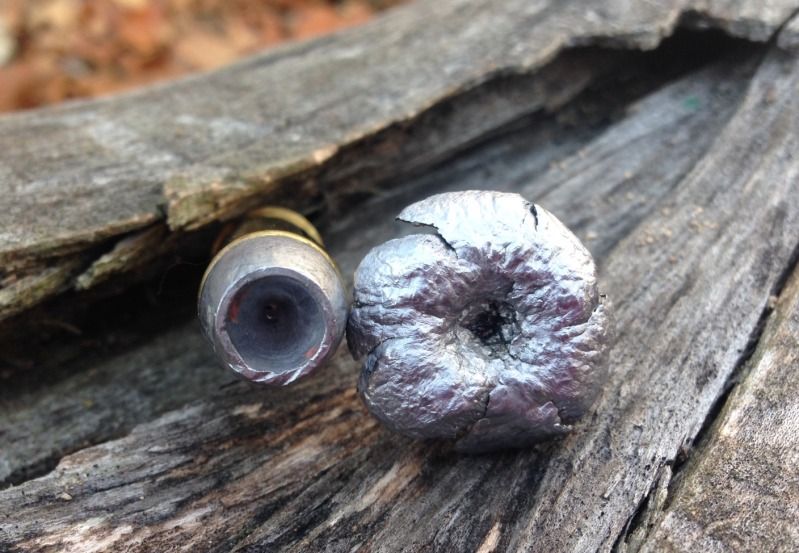These are not new concepts and folks have been using them for a LONG time but for a while, we seemed to have migrated away and thought that harder bullets must be better, and for certain applications, they certainly are but for normal non dangerous game hunting, I think the softer cast bullets are the best of both worlds.
Y'all are talking two different things right now. There is a difference in a soft nosed cast bullet and what we are using in the big HP in the 475/480 right now. The Soft nosed cast bullet was cast from two alloys by either using a dipper for the nose material followed by a hard alloy or the process used a two part mold as mentioned earlier.
The ones we are using now are a homogenous material. They are approximately 9 BRN. Now, the design of the bullet comes in as well which also goes back to the old Ross Seyfried material. This portion plays into a question you asked about earlier. Both bullet types are made to excel in circumstances mentioned. However, in both instances, the result and goal is the same. Achieve a "splash" when the bullet first hits as a jacketed bullet does and grab what expansion you can and then the usual penetration. However, unlike a jacketed bullet, which can shed a jacket or come to pieces due to construction of two or more alloys, the homogenous soft lead alloy stays together. If you shear the nose, the base continues to track forward and exits, I've never had a jacketed work like that for me on any critter if the nose section begins to separate from the majority of the bullet. At that point is when they usually come apart. On the soft NOSE cast bullet, the nose is the only thing that is soft, when they are water quenched during casting, the shank is probably 20-22 BRN and the nose is 5-6. It deforms FAST and can smear or wipe off but typically the "donut" will happen as mentioned in Ross's article. The splash happens at impact, the shank continues tracking through for your exit. I think Ross described it as a jacketed bullet with a built in safety valve or something like that. Haven't read the article in years, may need to go do that today...
Now the softer alloy bullets that we are using now are a mix of wheelweight and pure lead. Dick casts this at different mixtures depending on anticipated velocity. It is IMPERATIVE that the alloy mixture be adjusted for velocity or you are setting yourself up for failure. He has a mixture ratio that he uses for different velocity ranges and if you buy them from him, you have to let him know what you plan to run them at to make sure the mix is right. We have found that the 70/30 mix at 1100-1150 is just magic with the big 475 bullet which is exactly what Dick's velocity range indicated. You would never know he has been handgun hunting and casting forever would you

When I originally had the 385 grain 475 bullet design drawn up about 4-5 years ago, we went back and forth but I had several items I wanted for sure. Ability to cast solid or HP but the most important was that when the big HP pins were in place, that the base of the HP cavern left approximately 1 bullet diameter in length for the shank in the event that the bullet shed everything from the base of the HP cavern up. Ross's early studies showed that if the you had one diameter in length left of the shank if the nose sheared, then it would continue to travel straight and not veer. Now...this is where I think the homogenous material bullets really shine. Think about this for a second. The obvious advantage is that the homogenous bullet is MUCH less of a pain to cast for these guys. BUT, what I liked that really changed the game for me in shooting them is thinking about what Ross said about shank length and the design of the two part bullet. In order to achieve what he found was best for straight line tracking, it would mean that part of your bullet that is in contact with the bore will be pure lead. The best way to keep one from leading was to try and keep the pure lead portion only in the nose and forward of the driving band area. However, on some bullets, this would be a problem if you were to try and keep only one diameter of the bullet intact. Longer shanks can cause veering. There is the fact that portions of the leading will be "scrubbed" maybe by the super hard alloy behind it but with the homogenous bullets kept in the velocity range they are cast for, there are NONE of those problems. The bullet type is all one so you are not trying to bond two unlike materials together and they are more likely to stay together from the start. In the event that you do encounter something that is able to shed the mushroom portion of the slug during contact, the base continues straight and you get the result of a normal cast solid. You have in this case a .476" wadcutter busting out the other side. I was able to really see that portion shine last January. I shot a large pig that was like shooting concrete. Just solid muscle and no fat layer that you normally encounter. the nose petals sheared it appeared on two shots through the center of the shoulders. However, I had perfect in line exit holes. The internal damage was impressive to say the least. The lungs had absolutely no color, just pale off white look due to blood loss I guess. There were large holes through the lungs and the heart and continuing on the other side but there was evidence of the petals passing through the lungs as well. That is not a bad thing. The hog didn't go far as both shots were in pretty fast succession but I thought that it performed very well encountering such a dense animal at 40 yards. The same thing happened on the bison that was mentioned. I had two 1" holes in both rib cages and lost a petal in the offside shoulder on exit. But the bison was down in 3 seconds or so and blood loss was impressive. The old "ropes of blood" description came to mind as he turned sideways and had streams shooting out both sides as he fell.
We are getting 100% weight retention on the recovered samples and both that we have recovered on the 475 were .93-.95" in diameter with perfect mushrooms. You can follow this link and there are pics of the mushroom I recovered from a pig last December as well.
http://castboolits.gunloads.com/showthre...206#post3349206If you are a caster, you can buy one of the molds right now as we are doing a rerun for the MIHEC mold. We had enough requests due to the new Ruger that we thought it would be a good time to do it. We will close buy at 25 molds as Miha already has the mold blocks ready so this will be a FAST turnaround on these rather than the years of wait I had in the beginning when I did it the first time.
June of 1989 is the article you are looking for on Seyfried articles on the soft nose cast. Those are the two part design. I've used them on Elk and they did a good job, I just had a pissed and adrenaline pumped elk to shoot. the damage was extensive though, she just didn't know she was dead. Having said that though, I much prefer what we are using now. I have the 270 SAA HP bullets ready for 1100-1150 fps second loads in my Casull that are powder coated OD green and soft which should be GREAT in the new Ruger. Hope this helped a little, I know I left out a lot that I was thinking but can add it later if it comes back to me

PS....send me your email address and I'll send you an invite to my Dropbox where I have ALOT of the Ross articles in PDF format and you can download them there. There is also an index that will explain which are which in the month/year listing codes its saved in....
GS
Pics of the recovered bullet from a hog I shot last December. The shot was about 45 yards broadside. The hide must have stretched about 2 feet from the feel of it when she was on the ground. But I was happy to finally recover one. I felt sure I'd recover the bison slug but no dice. The load is 14.5 grains HS6 in the 475 Linebaugh and runs about 1100 from my 6" Freedom Arms gun. 15 grains ran 1167 from my 5.5" Linebaugh gun and that was the one I shot the bison with. I slowed it down due to the composition of the bullet being a little softer and it was running faster than I planned. I could see streaks of lead in barrel after about 20 shots. Not a problem but at 1100, I get absolutely no leading, amazing accuracy at 100 yards and perfect performance for what I'm wanting. It may not be everyone's cup of tea but it surely is working for me and a few others.



Here are a few of the 270 SAA bullets. Cast out at about 285 grains and are using the HP as well. They should be exceptional for deer. I wanted to try the powder coating thing so I coated these. The oven softens the bullet as you cure the powder. They are probably about 9-10 as well. I hit one with a small hammer three or four times just to see how powder coat reacted. It was pretty cool to see it cracked like the lead, and it DID NOT flake off like you would think. The bond that it makes with the lead is very surprising to me. Accuracy has been REALLY good on these bullets. My buddy Jeff Hoover has done and extensive amount of comparison shooting with the PC bullets over the last year in various calibers and guns and the results have been very positive. If you take some hard cast bullets out there and hit them with a hammer, they will break due to being too hard or having the wrong composition...that is NOT what you want if you are trying to break bone. You want something between what these are in this picture and what the brittle ones are. I guess what I'm saying is the same as always, match the bullet to the game. You can get too much of a good thing sometimes
